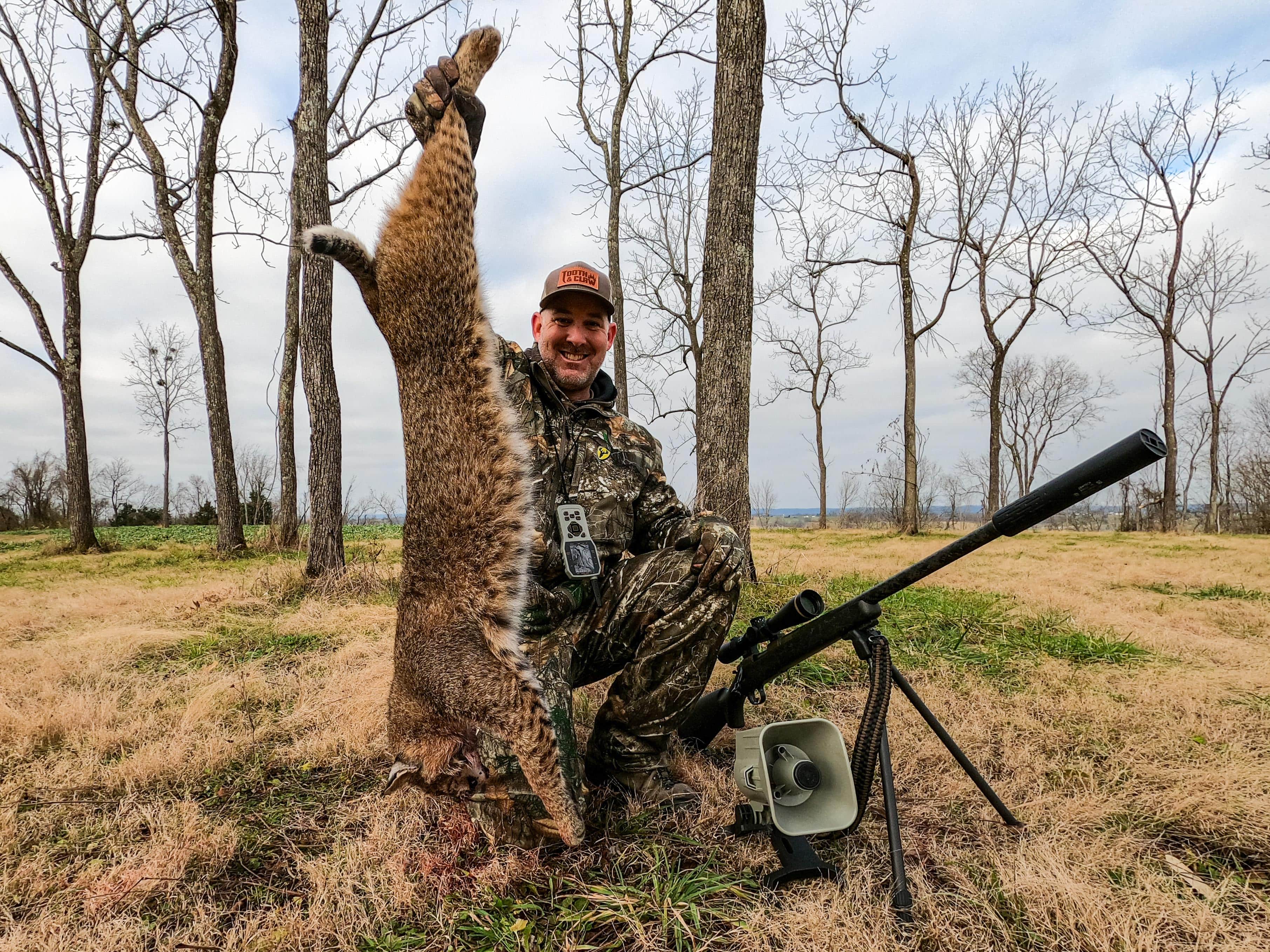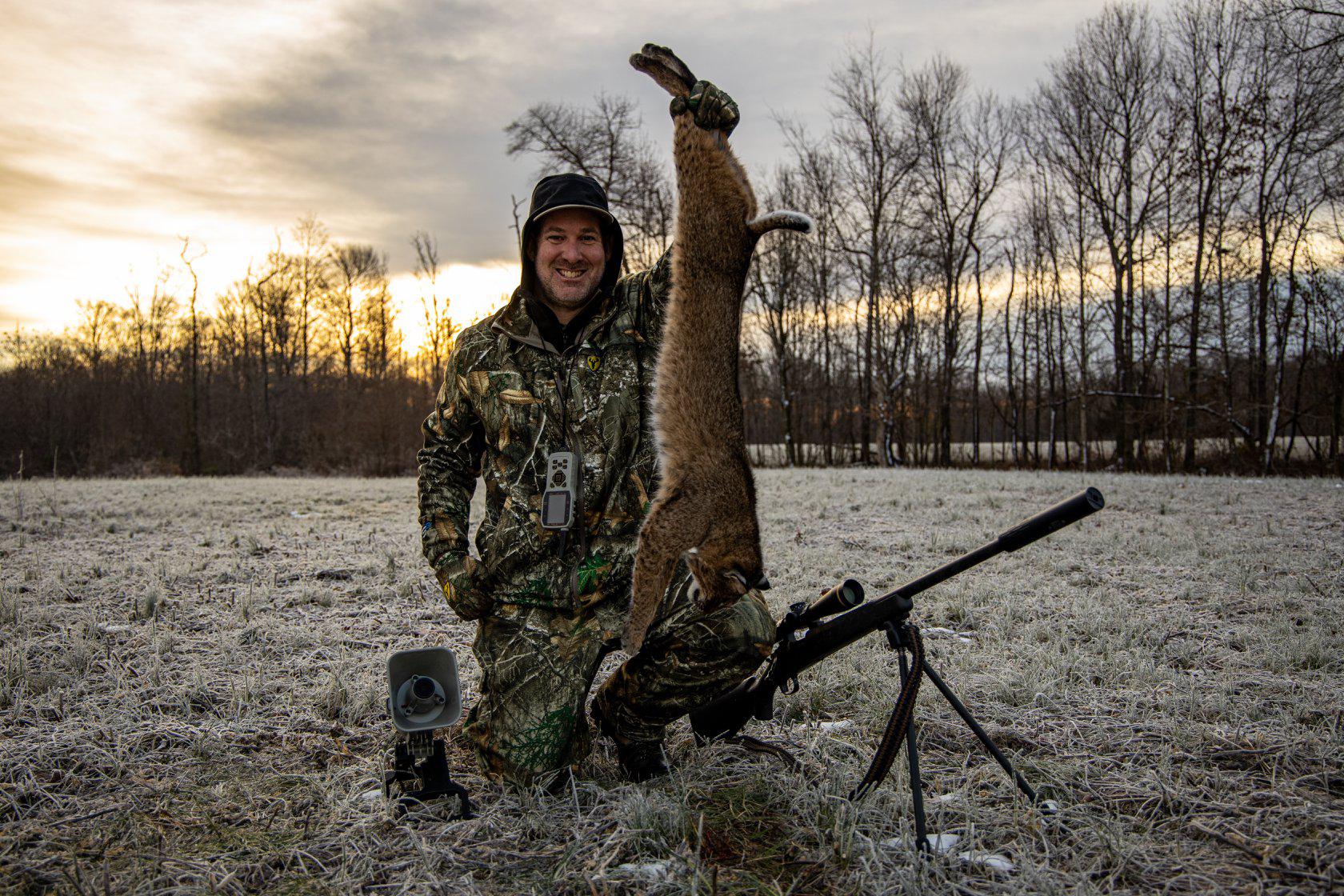Eastern Bobcat Hunting by Jon Collins
January 15, 2021
The tune of Mrs. McCottontail was singing out of the X24. My thumb positioned on the volume buttons, ramping the volume of the rabbit cries up and down. My attention was on the grown up fence row that led into a nasty thicket full of briars and treetops. Suddenly a group of birds were frantically communicating with each other straight down the fence row. I thought to myself, "Surely that means a bobcat is on its way."
All of a sudden a bobcat magically appeared no more that 50 yards in front of me. The bobcat's eyes were fixated on the call -flipping his tail as he stalked toward the sound. My rifle was already positioned in the direction of the X24. As the cat crossed in front of my gun barrel, I lip squeaked to stop him, settled the crosshairs on his shoulder, and squeezed the trigger. Pew! Thwap!!! There laid a bobcat just feet from the call. I walked up to the cat and was in awe - just like I am of every bobcat that I've been blessed to put my hands on.
After several years of calling bobcats in Kentucky, I've found that thorough scouting, smart stand selection, and solid calling techniques all work together to increase your odds of tagging bobcats.

Jon Collins with a bobcat successfully called in using a FOXPRO X24 digital game call
SCOUT FOR BOBCATS
Scouting is an important tool to take advantage of for bobcat success. It's pretty tough to call up a bobcat in a place that doesn't have them.
First things first, you have to find them. You'll rarely see a bobcat out in the wide open. Bobcats seem to love the thick stuff. Lots of times the thicker the better. Recently logged areas that have treetops scattered throughout and have grown up in thick briars can be hot spots for cats. Brushy creek bottoms, thick drainages, and even grown up fields can be places that bobcats love to hang out in and hunt.
Get out there and start looking for sign such as tracks & droppings. Probably the easiest way to find tracks is by walking travel corridors after a snow. Looking for tracks in mud and sand along creeks and pond banks can also pay off.
Take advantage of trail cameras. Trail cameras are an excellent scouting method for finding bobcats. Not only will they let you know if you have a cat to hunt, but they can also help you pattern a cat and let you know when you need to be in the area calling.
One thing I've learned over the years is if you call a bobcat in an area, there's a good chance you'll find success in that area year after year. I have a few stand locations that I can count on to produce a bobcat, year in and year out. There's actually a couple of locations that I don't dare call unless bobcat season is in because there's that good of a chance that a cat will stroll in.
STAND SELECTION
Stand selection is crucial for success. An ideal stand will have you set up tight on thick cover, but be in an area open enough for you to see. Setting up in woods or in thickets can be effective, but you take the chance of a bobcat coming into the call and sneaking back off without you ever seeing it. Plus, there's a good chance you could spook a bobcat walking in if you push too far into their area.
I personally like to find open areas such as a small field that is adjacent to where I have bobcats scouted. If possible I'll set up 50-75 yards away from the thick cover and place the FOXPRO out half the distance from me to the edge of cover. A bobcat isn't likely to cover a tremendous amount of open ground. So you'll need to set up close enough that a bobcat will feel comfortable to come to your call.
When it comes to wind direction for bobcats, you'll find that opinions differ. I'll give you mine - Always Hunt The Wind! I have seen bobcats circle to the downwind side of my FOXPRO on more than one occasion. I have also seen a bobcat enter my scent cone, get nervous, and run off without the opportunity to fire a shot. I have also called numerous coyotes (which never get a pass) while making bobcat stands. It doesn't matter if I'm calling for bobcats, coyotes, or fox - I'm always hunting the wind.

Jon Collins showcasing another successful harvest with the FOXPRO X24 digital game call
SOUNDS & SOUND SEQUENCES
I definitely have favorite sounds that I like to use on bobcat stands. In my experiences of calling bobcats, I've become a big fan of cottontail distress sounds. That being said, I've called cats in on jackrabbit, snowshoe hare, and various bird sounds. I've actually had success calling in bobcats on over a dozen different FOXPRO sound files.
A general bobcat sequence that I like to run starts out light and builds in intensity throughout the sequence. I'll usually run 3-4 different prey distress sound files resulting in a 15-25 minute stand depending on the location (most of the bobcats I call in show up under 8 minutes). For instance, I'll start out with a sound such as "Bay Bee Cottontail." I'll run that sound for 4-6 minutes. If a cat doesn't show, I'll pause for 20-40 seconds and then go into an adult cottontail sound such as "Mrs. McCottontail." Again, I'll run that sound for 4-6 minutes. If a cat still doesn't show I'll pause for 20-40 seconds again and then go into a snowshoe hare sound such as "Snowshoe Hare HP." If a bobcat still doesn't show I'll finish with a few minutes of a jackrabbit sound such as "Lightning Jack." As you can see, I like to start out light and increase with intensity with each successive sound. I've learned over the years that if a bobcat doesn't show on a sound played, they'll usually show up rather quickly after the next sound starts up. It's almost as if they are afraid they lost their chance to claim the rabbit and then charge in when another sound starts back up.
Over the last 2 years I've fallen in love with the new FOXPRO sound file "Mrs. McCottontail." I'm starting to think that it might be the best bobcat calling sound file ever recorded. After watching 8 different bobcats show up while that sound was playing, I've henceforth started leading off with "Mrs. McCottontail." I've recently tagged 2 bobcats that each came to the call in under 5 minutes to that sound.
CLOSING
It's an amazing sight to witness a bobcat come to the call. Sometimes they sneak in, stalking your call. At times they will come running in just like a coyote. Other times one will show up out of nowhere just sitting there scanning the area. No matter how they come to the call you need to be ready to capitalize on the opportunity. I wish you the best of luck on your next bobcat stand.
Shoot straight and shoot often.
FOXPRO welcomes thoughtful comments from our visitors. All comments are moderated prior to publication. Please review our Comments Policy.